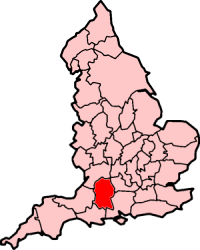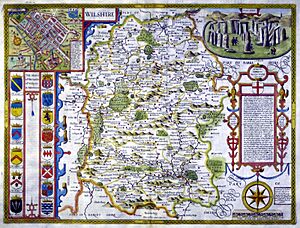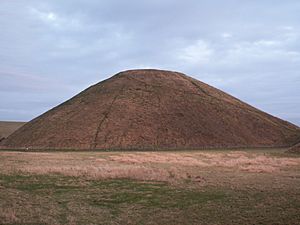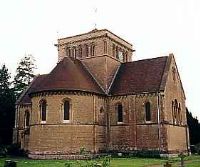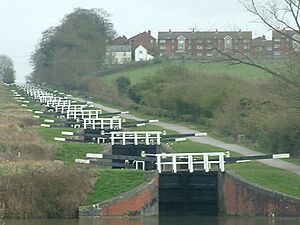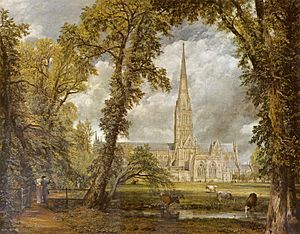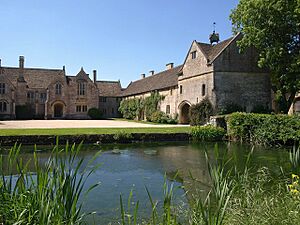History of Wiltshire facts for kids
Wiltshire is a historic county in the South West England region. It is landlocked and sits in the eastern part of the region.
Contents
- Medieval Wiltshire: Early History and Conflicts
- Land Ownership After the Norman Conquest
- Wiltshire's Ancient Divisions and Meeting Places
- Religious Areas and Administration
- Wiltshire's Role in Political History
- The English Civil War in Wiltshire
- The Glorious Revolution
- Wiltshire's Economy: From Farms to Factories
- Archaeology: Ancient Wonders of Wiltshire
- Architecture: Buildings of Wiltshire
- See also
Medieval Wiltshire: Early History and Conflicts
The history of Wiltshire began around 552 AD. This is when the Saxon leader Cynric won a battle against the native Britons at Old Sarum. This victory opened the way to Salisbury Plain.
A few years later, Cynric pushed through the Vale of Pewsey. He extended the West Saxon kingdom to the Marlborough Downs. This happened after another victory at Barbury Hill. At this time, the area south of the River Avon and the River Nadder was covered in thick forests. Some of these forests still exist today in Cranborne Chase.
The first Saxon settlers mostly lived in the valleys of the River Avon and the River Wylye. A small town called Wilton grew in the Wylye valley. This town gave the name Wilsætan to the new settlers.
By the 800s, the area had a clear way of being organized. Weohstan, a leader of the Wilsætan, was known for stopping an invasion by the Mercians. In 878, the Danes set up their base at Chippenham. They stayed there for a year, taking goods from the surrounding country.
During the time of Athelstan, there were places to make coins (mints) in Old Sarum, Malmesbury, Wilton, Cricklade and Marlborough. In 1003, Wilton and Salisbury were destroyed by Danish invaders led by Sweyn I of Denmark. Later, in 1015, Canute attacked the area.
Land Ownership After the Norman Conquest
After the Norman Conquest, land in Wiltshire was shared out again. More than two-fifths of the county went to the church. The king owned one-fifth of the land. Important non-church landowners included Edward of Salisbury and Ralf de Mortimer.
The first Earl of Wiltshire after the Conquest was William le Scrope in 1397. The title later went to other families, including the Paulet family in 1550.
Some religious houses, like the Benedictine ones at Wilton, Malmesbury, and Amesbury, were already there before the Conquest. New ones were built later. For example, Bradenstoke Priory was founded in 1142. Lacock Abbey was founded in 1232 by Ela, Countess of Salisbury.
Wiltshire's Ancient Divisions and Meeting Places
The county of Wiltshire was divided into areas called "hundreds." The Domesday Survey mentioned forty of these hundreds. Many of them, like Selkley and Ramsbury, still have similar names and areas today. Other hundreds were combined over time. For example, Thorngrave, Dunelawe, and Cepeham hundreds now form the modern hundred of Chippenham.
In the 1300s, church-owned lands were grouped into their own hundreds. The church owners made their tenants attend special courts in these hundreds. For instance, the bishop of Winchester had a hundred called Kurwel Bishop.
The meeting-place (or moot) for Swanborough Hundred was at Swanborough Tump. This is a small hill mentioned in the will of King Alfred. The main county court for Wiltshire was held at Wilton.
Religious Areas and Administration

When the West Saxon church area was divided in 703, Wiltshire became part of the diocese of Sherborne. But in 905, a separate diocese of Ramsbury was created. Its main church was sometimes in Ramsbury, Wilton, or Sonning.
Before the Norman Conquest, Ramsbury joined back with Sherborne. The main church then moved to Salisbury. Today, parts of Wiltshire belong to different church areas. For example, Chippenham and Malmesbury are part of the diocese of Bristol.
Wiltshire's Role in Political History
Wiltshire has usually been a peaceful county. It hasn't always played a huge role in major national political events.
In 1086, after the Domesday Survey was finished, a big meeting took place in Salisbury. All the landowners swore loyalty to the king there. Another similar meeting happened in Salisbury in 1116.
At Clarendon in 1166, important rules were made. These rules changed how justice was handled across the country. Parliaments (meetings of leaders) were held in Marlborough in 1267 and in Salisbury in 1328 and 1384.
During the wars of King Stephen, castles like Salisbury, Devizes, and Malmesbury were held by Roger, Bishop of Salisbury. He supported the Empress. But in 1138, Stephen captured the bishop and took Devizes Castle. In 1216, Marlborough Castle was given up to Louis by Hugh de Neville.
The English Civil War in Wiltshire
During the English Civil War in the 1600s, Wiltshire strongly supported the parliamentary side. Many people in the county were very against Catholics. The Marquess of Hertford tried to gather support for the king, but people in Wiltshire resisted strongly.
However, the Royalists (King's supporters) had some early successes. Marlborough was captured for the king in 1642. In 1643, the forces of the Earl of Essex were defeated by King Charles I and Prince Rupert at the Battle of Aldbourne Chase. In the same year, Sir William Waller was defeated at the Battle of Roundway Down near Devizes.
In 1645, a group called the Clubmen of Dorset and Wiltshire formed. They just wanted peace and would punish anyone from either side who stole things. Devizes, the last Royalist stronghold, was captured by Oliver Cromwell in 1645. A rising in Salisbury in 1655, supporting the exiled Charles II, was quickly stopped.
The Glorious Revolution
In 1688, during the Glorious Revolution, King James II gathered his main army of about 19,000 men at Salisbury. James arrived there on November 19, 1688. His soldiers were not eager to fight William and Mary. Many of them were not loyal to James.
The first small fight happened in Somerset. In Salisbury, James heard that some of his officers had left him. He had a nosebleed, which he saw as a bad sign. His commander advised him to retreat on November 23. The next day, John Churchill joined William's side. On November 26, James's daughter Princess Anne also left him. James returned to London that same day. He never again led a serious army in England.
Wiltshire's Economy: From Farms to Factories
At the time of the Domesday Survey, Wiltshire's economy was mostly about farming. The survey mentioned 390 mills and vineyards at Tollard Royal and Lacock. In the centuries that followed, sheep farming became very important. Monasteries like Kingswood and Stanley sold wool to markets in Florence and Flanders in the 1200s and 1300s.
Wiltshire was already known for its clothing industry. The main centers for making clothes were Bradford-upon-Avon, Malmesbury, Trowbridge, Devizes, and Chippenham.
In the 1500s, Devizes was famous for its blankets. Warminster had a well-known corn market, and much cheese was made in north Wiltshire. Amesbury was known for making tobacco pipes in the 1500s. The clothing trade faced hard times in the 1600s, partly because of many illnesses. Linen, cotton, gloves, and cutlery were also made in the county. Silk was made in Malmesbury and carpets in Wilton.
The Swindon Works of the Great Western Railway (from 1841 to 1986) was one of the largest covered areas in the world. Its remains are very important examples of Victorian engineering. Along with the homes and services provided by the company, it has been suggested as a World Heritage Site. Swindon has also been important in other manufacturing, like the car industry. You can learn more in the History of Swindon article.
Archaeology: Ancient Wonders of Wiltshire
Prehistoric Remains and Monuments
Wiltshire is full of amazing prehistoric sites. Tools made of flint and stone from the Stone Age can be seen in the excellent collection at Salisbury Museum.
Stonehenge, with its huge stone circles, and Avebury, with its long rows of monoliths leading to a stone circle, are the biggest and most famous ancient stone structures in England. A valley near Avebury is filled with giant sarsen blocks. They look like a "river of stone" and might have been placed there by ancient builders. There are also menhirs (single standing stones) and dolmens (stone tables).
It's clear that the open areas (downs) were home to many people a very long time ago. Circles made by a ditch and bank are common. So are grave-mounds, called barrows. These barrows are classified by their shape, like bell barrows, bowl barrows, and long barrows. Bones, ash, tools, weapons, and ornaments have been found in these mounds. Many of them contain kistvaens, which are stone chambers. The lynchets, or terraces, on some hillsides are thought to be the work of early farmers.
Ancient strongholds are found all over the county. Some of the most notable are Vespasian's Camp near Amesbury and Silbury Hill. Silbury Hill is the largest artificial mound in Europe, located near Avebury. Other important sites include the mounds of Marlborough and Old Sarum. There are also "camps" like Battlesbury and Scratchbury near Warminster. Yarnbury is well-preserved north of Wylye. Durrington Walls, north of Amesbury, are likely the remains of an ancient village.
Roman Remains
There are many signs of Roman rule in Wiltshire. Wansdyke, or Wodens Dyke, is one of the largest ancient earthworks. It runs west for about 100 km from east of Savernake. It is almost unchanged for several kilometers along the Marlborough Downs. Its exact age is not known, but excavations show it is Roman or Romano-British. It has a bank with a trench on the north side. It was clearly built for defense, not just as a boundary. Forts were built along it to make it stronger.
Recent Discoveries
In April 2022, people using metal detectors found two 4000-year-old Bronze Age axe heads. They were found on a farmer's land. These ancient items are now kept at the Bristol Museum.
Architecture: Buildings of Wiltshire
Historic Churches and Monasteries
Monastic Houses
Some of the most important monastic buildings that still have parts remaining are the ruined abbeys of Malmesbury and Lacock. Malmesbury Abbey is still used as a church today. The Church of St Mary and St Melor in Amesbury might have been connected to an old monastery there.
Monkton Farleigh had a Cluniac priory. Its old outbuildings are now part of a manor house. A special college was founded in 1347 at Edington. Its church is very large and beautiful, like a cathedral, and is now the local parish church.
Notable Churches
The most beautiful churches in Wiltshire are usually in the Perpendicular style. They were built where good stone was available. In areas with chalk, where flint was used, the churches are simpler. Small wooden steeples and pyramid-shaped bell-turrets are common. The churches of Purton and Wanborough are unusual because they have a central steeple and a tower at the west end.
St. Lawrence's church at Bradford on Avon is one of the most complete Saxon church buildings in England. Other churches have parts of Saxon work built into later stone. Examples include three arches in the nave of Britford church and parts of the churches at Avebury and Bremhill.
St John's church in Devizes still has its original Norman tower. The chancel of St Mary's in the same town is also Norman. Churches like Preshute and Netheravon also have some Norman features.
Early English architecture is best seen in Salisbury Cathedral. It is a very pure and beautiful example of this style. Smaller examples can be found at Amesbury and Bishops Cannings.
Bishopstone has the finest Decorated church in the county. It has a unique south chancel doorway. Mere has an interesting Perpendicular church. It also has a medieval chantry (a small chapel) that was used as a school by the poet William Barnes.
Secular Architecture: Castles and Manor Houses
Castles
Most of Wiltshire's castles have almost disappeared. At Old Sarum, Marlborough, and Devizes, only a few walls and underground rooms are left. Castle Combe and Trowbridge castles were torn down long ago. Only a small part of Ludgershall castle remains.
The ruins of Wardour castle are near Tisbury. They date from the 1300s. They consist of a tall, six-sided outer wall with an open courtyard inside. Two towers stand over the entrance.
Manor Houses
Wiltshire has many large, old country houses and stately homes. Few areas, especially in the northwest, are without an old manor house. These are often used as farms now. But they still have their flagged floors, stone-framed windows, gabled fronts, and oak-paneled rooms. Place House in Tisbury and Barton Farm at Bradford-upon-Avon date from the 1300s.
The best examples from the 1400s are the manor houses of Norrington and Great Chalfield. At South Wraxall, the hall of a beautiful house from this time is famous. Local stories say that Sir Walter Raleigh first smoked tobacco there with his host, Sir Walter Long.
Later styles are seen in places like Longford Castle near Salisbury, which has amazing art galleries. Other notable homes include Wilton House at Wilton, Bowood House near Calne, Longleat near Warminster, and Stourhead. Each of these is special for its design, art, or beautiful surroundings.
|
See also
- History of England
- Wiltshire Victoria County History
- Wiltshire Record Society
- Wiltshire and Swindon History Centre


